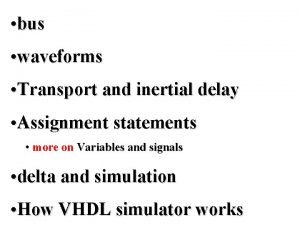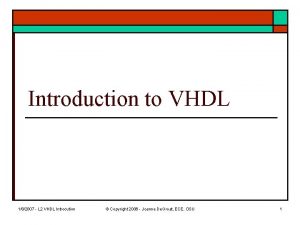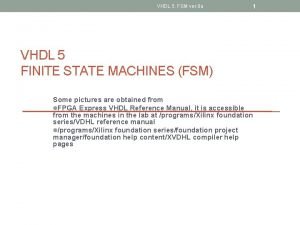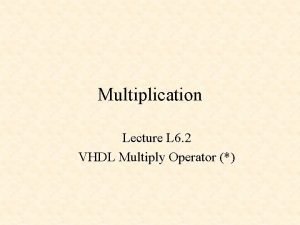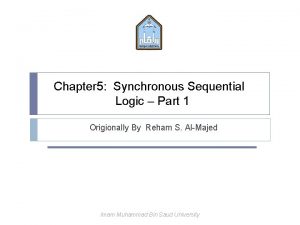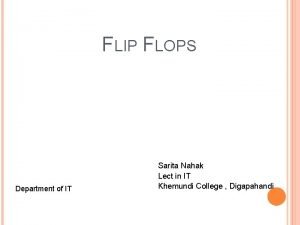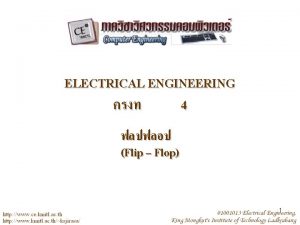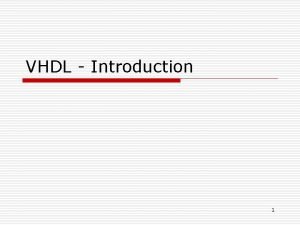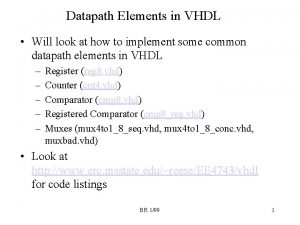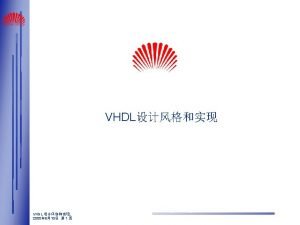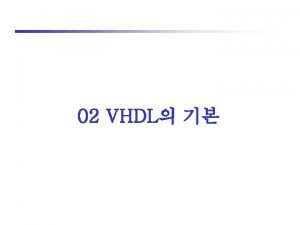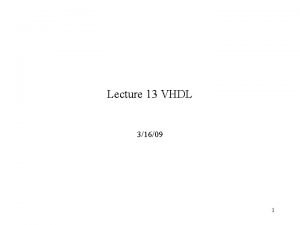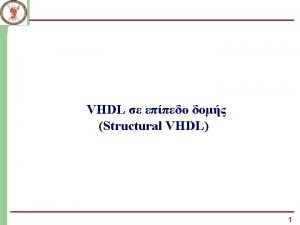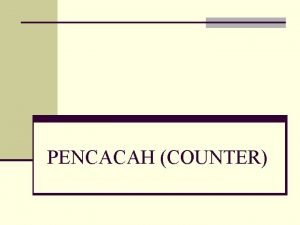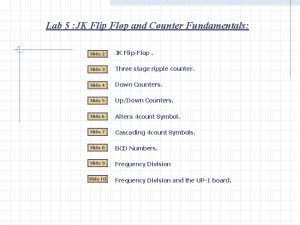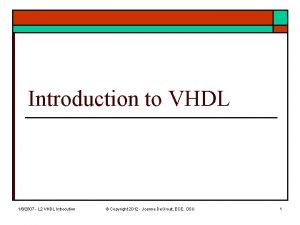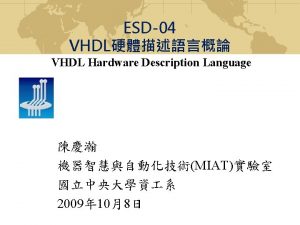VHDL signal Counter signal TC signal flop stdlogicvector3



















































- Slides: 51







相应的VHDL代码 signal Counter: signal TC: signal flop: std_logic_vector(3 downto 0); std_logic; process(Clk) begin if rising_edge(Clk) then Counter <= Counter + 1; end if; end process; TC <= ‘ 1’ when Counter=“ 1111” else ‘ 0’; process(TC) begin if rising_edge(TC) then flop <= … end if; end process; VHDL 设计风格和实现, 2000年 6月10日 第 7 页 --TC为组合逻辑输出 --使用组合逻辑输出作时钟,是异步设计,禁止!!!



相应的VHDL代码 signal Asyn. Input: signal Input. Reg: signal Delay: signal Syn. Input: std_logic; process(Syn. Input, Asyn. Input) begin if Syn. Input=‘ 1’ then --此置位为寄存器信号,为同步设计,可行 Input. Reg <= ‘ 0’; if rising_edge(Asyn. Input) then Input. Reg <= ‘ 1’; end if; end process; process(Clk) begin if rising_edge(Clk) then Delay <= Input. Reg; Syn. Input <= Delay; end if; VHDL 设计风格和实现, 2000年 6月10日 第 10 页


相应的VHDL代码 signal Counter: signal TC: signal flop: std_logic_vector(3 downto 0); std_logic; process(TC, Clk) begin if TC=‘ 1’ then Counter <= “ 0000”; TC <= ‘-’; elsif rising_edge(Clk) then Counter <= Counter + 1; if Counter=“ 1110” then else end if; end process; VHDL 设计风格和实现, 2000年 6月10日 第 12 页 TC <= ‘ 1’; TC <= ‘ 0’; --此复位为寄存器信号,为同步设计,可行 --注意和异步设计中TC信号的比较 --此处TC为寄存器输出

同步设计的更多例子(可行) Counter INPUT D Q 1 Q 0 CLOCK INPUT Counter D TC DATA D S Q CE CLOCK R VHDL 设计风格和实现, 2000年 6月10日 第 13 页

相应的VHDL代码 例1 signal Counter: std_logic_vector(1 downto 0); process(Clk) begin if rising_edge(Clk) then if INPUT=‘ 1’ and Counter/=“ 11” then Counter <= Counter + 1; end if; --组合逻辑用在寄存器的D端, --为同步设计,可行 end if; end process; 例2 signal Counter: std_logic_vector(3 downto 0); signal TC: std_logic; signal s: std_logic; process(Clk) begin if rising_edge(Clk) then if INPUT=‘ 1’ then Counter <= Counter + 1; end if; if TC=‘ 1’ then --TC 用在寄存器的CE端,为同步设计,可行 s <= DATA; end if; end process; TC <= ‘ 1’ when Counter=“ 1111” else ‘ 0’; --TC为组合逻辑输出 VHDL 设计风格和实现, 2000年 6月10日 第 14 页

异步设计的更多例子(禁止) Counter INPUT D Q 1 Q 0 CLOCK Async R Counter INPUT D TC DATA D S Q CE CLOCK R 这些例子有什么问题 ? VHDL 设计风格和实现, 2000年 6月10日 第 15 页

相应的VHDL代码 例1 signal Counter: std_logic_vector(1 downto 0); process(Counter, Clk) begin if Counter=“ 11” then --组合逻辑用作寄存器的异步复位, --为异步设计,禁止!!! Counter <= “ 00”; elsif rising_edge(Clk) then if INPUT=‘ 1’ then Counter <= Counter + 1; end if; end process; 例2 signal Counter: std_logic_vector(3 downto 0); signal TC: std_logic; signal s: std_logic; process(Clk) begin if rising_edge(Clk) then if INPUT=‘ 1’ then Counter <= Counter + 1; end if; end process; TC <= ‘ 1’ when Counter=“ 1111” else ‘ 0’; --TC为组合逻辑输出 process(TC) begin if rising_edge(TC)=‘ 1’ then --TC 用作寄存器的时钟,为异步设计,禁止! s <= DATA; end if; end process; VHDL 设计风格和实现, 2000年 6月10日 第 16 页



















了解进位链流向 w XC 4000 E/L和Spartan/XL进位链流向为上下两个方向 w XC 4000 EX/XL/XV和Virtex器件的进位链流向只能向上 MSB LSB XC 4000 E Spartan/XL VHDL 设计风格和实现, 2000年 6月10日 第 35 页 XC 4000 EX/XL/XV Virtex




I/O速度:FPGA的输出时间Tco w FPGA输出时间的计算公式: Tco = Tcyc - Tsu(down) - Tbrd - Tbufg w 使用“OFFSET OUT”对Tco进行约束 XCV 400 FPGA 下游器件 Tco Tbufg D Q Tsu(down) Tbrd CE CE Clock (Tcyc) VHDL 设计风格和实现, 2000年 6月10日 第 39 页 D Q



使用I/O寄存器的例子(FPGA-FPGA) 发送器(XCV 100 -4 FPGA) D 接收器(XCV 100 -4 FPGA) D Q Q CE CE 使用IOB中寄存器的时延 Tiockp + PCB网络时延 + Tiopick 5. 649 1. 962 =7. 611 不使用IOB中寄存器的时延 (Tcko + Tnet +Tioop) + PCB网络时延 + (Tiopi + Tnet + Tdick) (1. 372 +0. 756+5. 652) (0. 989+ 1. 930+0. 728) 7. 780 3. 647 =11. 427 VHDL 设计风格和实现, 2000年 6月10日 第 42 页


I/O速度的其他提示 w XC 4000 -13, 36, 62 XL是turbo boosted。 w 使用BUFG,可提高pin to pin时延 VHDL 设计风格和实现, 2000年 6月10日 第 44 页


资源估计 w w w 资源使用量是指FPGA使用了的百分率 在宏、库、以及XAPP application notes 中找到可比较的函数来估计资源使用量 — 或者,使用别的设计来估计器件使 用率 快速实现,然后查看MAP报告 Design Summary — 选择“Implementation/ View Report -------Number of errors: 0 Number of warnings: 644 Files/ Map report” Number of Slices: 1, 147 out of 1, 200 95% — Slices, IOBs, Block RAMs, 以及其 Slice Flip Flops: 735 input LUTs: 1, 046 (1 used as a route-thru) 他部件分别列出,并给出使用百分 4 Dual Port RAMs: 312 Number of Slices containing 率。最后给出相当于ASIC的门数 unrelated logic: 0 out of 1, 147 0% Number of bonded IOBs: 85 out of 98 86% IOB Flip Flops: 68 Number of Block RAMs: 10 out of 10 100% Number of GCLKs: 2 out of 4 50% Number of GCLKIOBs: 2 out of 4 50% Number of DLLs: 1 out of 4 25% Number of Startups: 1 out of 1 100% Number of RPM macros: 9 Total equivalent gate count for design: 224, 805 Additional JTAG gate count for IOBs: 4, 176 VHDL 设计风格和实现, 2000年 6月10日 第 46 页





 Counter fsm
Counter fsm Analog electronics
Analog electronics T flip flop synchronous counter
T flip flop synchronous counter 3 bit twisted ring counter
3 bit twisted ring counter Site:slidetodoc.com
Site:slidetodoc.com Counter in digital electronics
Counter in digital electronics Vhdl counter example
Vhdl counter example Vhdl global variable
Vhdl global variable Difference between signal and variable in vhdl
Difference between signal and variable in vhdl Even odd signals
Even odd signals Baseband signal and bandpass signal
Baseband signal and bandpass signal Baseband signal and bandpass signal
Baseband signal and bandpass signal Digital signal as a composite analog signal
Digital signal as a composite analog signal Cmos leakage current
Cmos leakage current Vhdl full form
Vhdl full form Flip flop methode
Flip flop methode Vhdl
Vhdl Instructional management jacob kounin
Instructional management jacob kounin D ff excitation table
D ff excitation table 7 segment display vhdl
7 segment display vhdl Vhdl modem
Vhdl modem Vhdl
Vhdl Package declaration in vhdl
Package declaration in vhdl Vhdl
Vhdl Level sensitive flip flop
Level sensitive flip flop Vhdl multiply
Vhdl multiply Flip flop ece
Flip flop ece S r q logic
S r q logic Jk flip flop
Jk flip flop Verilog vs vhdl
Verilog vs vhdl Timing diagram jk flip flop
Timing diagram jk flip flop Fosberry flop
Fosberry flop Rs-ff
Rs-ff D latch
D latch Vhdl asic
Vhdl asic Vhdl code for serial adder
Vhdl code for serial adder Ic 7476
Ic 7476 Vhdl automat
Vhdl automat Ollózó technika
Ollózó technika Jk flip flop
Jk flip flop Truth table for sr flip flop
Truth table for sr flip flop One flip flop per state method
One flip flop per state method Vhdl history
Vhdl history Que significan las siglas ieee
Que significan las siglas ieee Vhdl
Vhdl Latch sr con habilitacion
Latch sr con habilitacion Datapath vhdl
Datapath vhdl Instanziazione
Instanziazione Flip flop çeşitleri
Flip flop çeşitleri Ieee vhdl
Ieee vhdl Chris the flip flop doc
Chris the flip flop doc Flip flop waveform
Flip flop waveform








